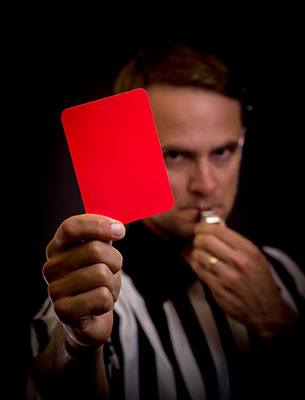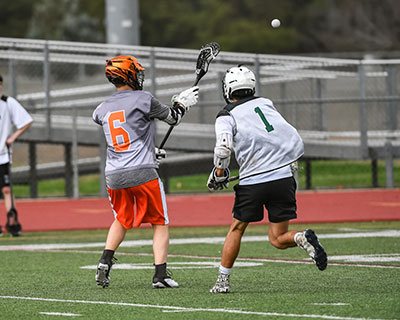Roughness on the lacrosse field is an inevitable part of a competitive game. However, it's important to make sure that you and your team abide by the rules set in place.
Unnecessary roughness can put your team at risk for penalties and suspensions, which could cost them games.
With this guide, we're here to dive into some detailed information about lacrosse's unnecessary roughness penalty and provide tips on avoiding such costly mistakes down the road.
Whether you are a player or coach looking to brush up on your skillset or someone who just wants to learn more about lacrosse safety regulations – this post has something for everyone, so read on!
More...
Take away key points:
What is unnecessary roughness in lacrosse?
Unnecessary roughness in lacrosse is an act of aggression against the game's fundamental principle of fair play. Therefore, unnecessary roughness in lacrosse is ruled if found that body checks could be avoided.
It can involve physical contact that is too aggressive and could be dangerous to the opposing team, such as charging or body checking, as well as unsportsmanlike verbal interactions.
Suppose a player disregards safety and fairness to the detriment of their opponent's crosse in any way. In that case, it is considered unnecessary roughness and can result in a penalty or even expulsion from the game.
Strict rules have been put into place regarding allowable contact on the field to ensure fair play for all competitors involved. But ultimately, it is up to the referee's discretion and discretion on whether or not a check constitutes unnecessary roughness.
Examples of unnecessary roughness
Examples of unnecessary roughness in lacrosse include:
- Striking an opponent with a stick or body using excessive or violent force.
- Intentionally hitting, elbowing, pushing, or tripping another player.
- Hitting another player with a stick in the head, neck, or back without the possession of the ball being involved.
- Checking an opponent from behind so that their feet are taken out from under them, resulting in a dangerous fall.
- Holding on to someone when they do not have possession of the ball.
- Making contact while attempting to retrieve a loose ball instead of using footwork to gain possession.
The result of the unnecessary roughness

Playing lacrosse requires proper technique and strategy. However, as in any sport, inappropriate behavior, such as unnecessary roughness, can occur and cause injuries to other players.
When a player commits technical fouls due to roughness, they are punished with a 3-minute service in the penalty box. During this time, they must sit out of the playing field and cannot influence the gameplay or score goals.
The purpose of the penalty is to teach players the importance of sportsmanship and fair play. On top of this immediate penalty, if the severity of the foul warrants it, further consequences may include suspension or expulsion from a game and possibly the entire season.
It is fair to say that such harsh discipline should serve as a deterrent to any would-be perpetrators of unnecessary roughness to ensure maximum safety among all players on both teams.
Penalties similar to unnecessary roughness
Penalties similar to unnecessary roughness in lacrosse include:
- An illegal body checking (IBC) penalty: involves a player making contact with an opposing player's head, neck, or back without the ball being involved.
- Unsportsmanlike conduct penalty: Players who use profanity or taunt their opponents are subject to this penalty
- Cross-checking penalty: This is when a player holds the stick with both hands and pushes or jabs it into an opponent's body.
- Slashing penalty: Occurs when a player strikes another player with his/her lacrosse sticks behind the head or neck area.
- Tripping penalty: When a defensive player tries to trip an offensive player by placing their stick, arm, or leg in their path.
- Interference penalty: When a player interferes or obstructs the freedom of movement of their opponent, apart from when they have ownership over the ball, are within five yards of each other, and are also in close proximity to a loose ball.
9 personal fouls in lacrosse
Personal fouls in lacrosse include there types below
1. Holding
The holding lacrosse penalties are personal foul that occurs when a player impedes, or a team intentionally holds onto an opponent who does not have possession of the ball. This can happen on the field or off, and both players have usually assessed a one-minute penalty for this infraction.
2. Illegal body check (IBC)

Illegal body check (IBC) in lacrosse is a personal foul that occurs when a player makes contact with another player using their body without possessing the ball. This can include pushing, charging, swinging an arm or lacrosse stick at another player, or simply conducting an avoidable body check.
An IBC penalty is usually assessed as a two-minute penalty. In addition, the offending player is removed from the field of play for one full minute without conducting normal offensive play.
3. Cross-checking
The cross-checking penalty in boys lacrosse is a personal foul that occurs when a player uses their stick to make contact with a player from behind. This can include pushing, charging, or swinging an arm or stick at another player. This kind of checking is found illegal and considered dangerous, as it limits the opponent's movement and can lead to injury.
An IBC penalty is usually assessed as a two-minute penalty, and the offending player is removed from the field of play for one full minute.
4. Slashing
The slashing penalty in boys lacrosse is a personal foul that occurs when a player uses their stick to make contact with an opposing player from any direction. This can include pushing, charging, or swinging an arm or stick at another player.
Slashing is considered dangerous, as it limits the opponent's movement and can lead to injury. An IBC penalty is usually assessed as a two-minute penalty, and the offensive player is removed from the field of play for one full minute.
5. Unsportsmanlike conduct
The unsportsmanlike conduct penalty in lacrosse is a personal foul that occurs when a player or a coach commits inappropriate or dangerous behavior.
The considered unsportsmanlike conduct can include taunting, fighting, using excessive force, illegal body check, trash-talking, using obscene language, or demonstrating poor sportsmanship on the field of play.
An IBC penalty is usually assessed as a two-minute penalty, and the offender is removed from the field of play for one full minute.
6. Tripping
The tripping penalty in lacrosse is a personal foul that occurs when a player obstructs and uses their hands and/or feet to trip an opposing player.
For example, this can occur when a player thrusts the opposing player or kicking, pushing, or pulling another player's feet out from under them.
Tripping is considered dangerous, as it limits the opponent's movement and can lead to injury.
7. Interference
The interference penalty in lacrosse is a personal foul that occurs when players interfere with their opponent's ability and free movement to play the game.
This can include obstructing their path, deliberately impeding their progress, or physically getting in their way while attempting to take a shot or pass.
8. Offside/Illegal procedure
The offside/illegal procedure penalty in lacrosse is a technical foul that occurs when players are found to be positioning themselves in a way that violates the rules of the game.
This could include having too many players on the midfield line or not having at least four players on the defensive side and three players on the offensive side, or being illegally positioned within the shooting or passing lanes.
9. Screening
Screening in lacrosse is a defensive strategy that involves one player obstructing an opposing player's view of the ball, preventing them from stealing or gaining control of it.
However, an illegal screen can occur when an offensive player moves and tries to block the defensive player.
Final words
In conclusion, the lacrosse unnecessary roughness penalty is a serious infraction that can have serious consequences. All players must remain aware of the rules and regulations associated with this penalty.
Failure to adhere could result in serious disciplinary action, such as suspension or expulsion from the game. This penalty should also be taken seriously by coaches and officiating crews, who should strive to ensure that all field players follow appropriate safety protocols.
